Nuestro grupo organiza más de 3000 Series de conferencias Eventos cada año en EE. UU., Europa y América. Asia con el apoyo de 1.000 sociedades científicas más y publica más de 700 Acceso abierto Revistas que contienen más de 50.000 personalidades eminentes, científicos de renombre como miembros del consejo editorial.
Revistas de acceso abierto que ganan más lectores y citas
700 revistas y 15 000 000 de lectores Cada revista obtiene más de 25 000 lectores
Indexado en
- Índice Copérnico
- Google Académico
- Abrir puerta J
- Revista GenámicaBuscar
- InvestigaciónBiblia
- Biblioteca de revistas electrónicas
- Búsqueda de referencia
- Universidad Hamdard
- EBSCO AZ
- OCLC-WorldCat
- Catálogo en línea SWB
- Biblioteca Virtual de Biología (vifabio)
- publones
- Fundación de Ginebra para la educación y la investigación médicas
- ICMJE
Enlaces útiles
Revistas de acceso abierto
Comparte esta página
Abstracto
Value of 18F-FDG-PET/CT Initial Staging in No Metastasic Breast Cancer with Poor Prognostic Factors
Alberto Martinez Lorca, Alejandro Gallego, Cristina Escabias and Pilar Zamora
Purpose: This study analysed retrospectevely the impact of 18F-FDG-PET/CT initial staging, in women with poor prognosis factors breast cancer, in our usual practice.
Methods: From January 2009 to December 2012, initial breast cancer underwent PET/CT in 298 women with one of these poor prognosis factors: Her-2+ or triple negative phenotype, Ki 67 ≥ 14%, tumoral size and/or positive axilary lymph nodes. Only 254 patients diagnosed with mammography, ultrasonography, MRI, and bone scintigraphy accomplished inclusion criteria.
Results: 18F-FDG-PET/CT changed 13.4% to IV clinical stage, detected metastatic disease in 3.3% of patients with stage I, 13% with stage II and 17.4% with stage III. Statistical significance was found between the PET/CT metastatic disease findings and patients with stage IIB and III(A-C)(OR:3.04;IC95%:1.2-7.2;p=0.009). PET/CT also revealed N3 disease in 7.9%. According to the location, visceral affectation was found in 4.7% of the patients, metastatic lymph nodes in 3.2% and secondary bone disease in 8.7%. Her-2 negative and hormonal positive receptors group submitted a higher incidence of distant metastases, 15.5%. The more visceral and lymph node disease (N3 and distant-M1) was found in the triple negative group. Metastatic disease was observed in 28.6% of the patients above 70 years, a higher incidence than those patients with lower age (OR: 3.7; IC95%: 1.7 - 8; p = 0.01).
Conclusion: 18F-FDG-PET/CT showed to be useful in the metastatic disease detection from IIB stage patients in initial poor prognosis breast cancer patients. The incidence of distance affectation was higher in patients above 70 years and in the Her-2 negative and hormonal positive receptor group.
Revistas por tema
- Agricultura y acuicultura
- Alimentación y Nutrición
- Bioinformática y biología de sistemas
- Bioquímica
- Ciencia de los Materiales
- Ciencia general
- Ciencias Ambientales
- Ciencias Clínicas
- Ciencias farmacéuticas
- Ciencias Médicas
- Ciencias Sociales y Políticas
- Ciencias Veterinarias
- Enfermería y atención sanitaria
- Física
- Genética y biología molecular
- Geología y Ciencias de la Tierra
- Ingeniería
- Inmunología y Microbiología
- Química
Revistas clínicas y médicas
- Anestesiología
- Biología Molecular
- Cardiología
- Cirugía
- Cuidado de la salud
- Dermatología
- Diabetes y Endocrinología
- Enfermedades infecciosas
- Enfermería
- Gastroenterología
- Genética
- Inmunología
- Investigación clínica
- Medicamento
- Microbiología
- Neurología
- Odontología
- Oftalmología
- Oncología
- Pediatría
- Toxicología

 English
English  Chinese
Chinese  Russian
Russian  German
German  French
French  Japanese
Japanese  Portuguese
Portuguese  Hindi
Hindi